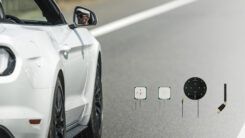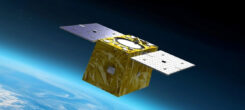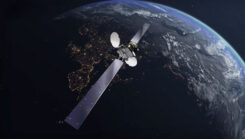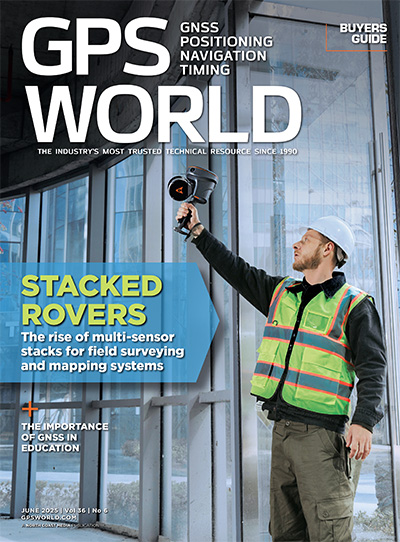The Modernized L2 Civil Signal

 |
A funny thing happened on the road to GPS modernization: a signal suddenly changed.
After years of preparation, modernization called for:
- implementing military (M) code on the L1 and L2 frequencies for the Department of Defense (DoD)
- providing a new L5 frequency in an aeronautical radio navigation service (ARNS) band with a signal structure designed to enhance aviation applications
- adding the C/A code to L2.
Implementation was underway when the System Program Director for the GPS Joint Program Office (JPO) asked whether it was wise simply to replicate the 20th-century C/A code in a 21st-century "modernized" GPS.
Responding to this challenge, a truly modern L2 civil (L2C) signal was designed in a remarkably short time to meet a much wider range of applications. The first launch of a Block IIR-M satellite in 2003 will carry the new signal, as will all subsequent GPS satellites.
As a result, civil GPS product designers eventually will have at least three rather different types of GPS signals to choose from. It also would be desirable for GPS III to add a modern civil signal to L1, further increasing the number of design choices. Depending on the application, designers will be able to select signals based on power, center frequency, code clock rate, signal bandwidth, code length, correlation properties, threshold performance, interference protection, and so on.
 Figure 1 Introduction of new signals (authors’ estimate, as funding not finalized) |
As well as describing the technical characteristics of the L2C signal, this article investigates how it will be used, what difference it will make, and how it will affect both users and manufacturers. To explore these issues, we invite you to eavesdrop on a meeting held on September 16, 2008.
The Scene: 2008
The meeting started at 9:00 a.m. in a small conference room at Acme Industries. Fred, Acme’s product development manager, had attended ION GPS-2008 the previous week, and he wanted an update on the GPS chipset alternatives for the 2009 product introductions. He had invited only three other people: Charley, who headed Acme’s dual-frequency and high precision GPS product developments, Valerie, who headed GPS-based consumer product developments, and Albert, from marketing.
Under Fred’s direction, Acme offered a wide array of GPS and non-GPS products for both the professional and consumer markets. Years ago Acme had recognized how important GPS was for many applications, so it acquired a few small companies with expertise in designing and applying positioning technology. By 2008, Acme had become a major supplier of GPS-based equipment for high precision, OEM, and consumer applications, although it had not entered the aviation or military markets.
 Figure 2 New signal availability |
At the ION conference, GPS chipset vendors had impressed Fred with the wide variety of options available, including single-frequency and multi-frequency chipsets for all three civil GPS signals at L1, L2, and L5. He knew Charley and Valerie were on top of these trends, so he wanted a better understanding of the new options and what they might mean for Acme’s markets.
Fred asked Valerie to explain why she used only L1 C/A chipsets for consumer applications, while Charley had been using dual-frequency chipsets for years.
Valerie said "show slide one," and her palmtop transmitted it to the conference room projector (see Figure 1).
Consumer Applications
"Thirty satellites now transmit L1 C/A," Valerie began, "but as this slide shows, only 20 have the L2 civil signal, and only nine have the L5 signal. I think Al agrees we can’t sell single-frequency L2 products until there are at least 24 satellites in good orbit positions. Until then, even with a better signal, we can’t overcome the geometry advantage a 30-satellite constellation gives L1-only products." Al made a note and nodded agreement.
"A year from now, in late 2009," she continued, "we expect to see a good 24-satellite L2 constellation, so I’m starting to design for L2. But there’s no guarantee. I don’t know whether we should put all our chips on L2 – no pun intended – or delay another year until we’re sure of the constellation, or offer two flavors of equipment and let our customers decide. We also don’t know what our competitors will do, so our options seem to be either picking one signal and taking the market risk or spending the extra money to cover both options."
"Why are there so many more L2 than L5 signals?" Fred asked.
 Figure 3 L2 signal options in IIF satellites |
Valerie showed slide two (see Figure 2) and explained, "Before the first IIR-M ‘modernized’ satellite was launched in 2003, GPS provided only three navigation signals, right from the first Block I in 1978 through the last unmodified IIR. Of the three signals, only the L1 C/A was designated for civil use.
"Twelve IIR satellites were modernized into IIR-Ms to speed-up the availability of the military M code on L1 and L2 and the civil code on L2. However, it wasn’t feasible to put L5 on the modified satellites. That had to wait for the IIF series now being launched. So, until the twelve IIR-M satellites reach end of life and are replaced, L5 won’t be on every satellite. Any delay is a shame, however, because L5 is a great signal."
High-Precision Applications
Charley then explained why his dual-frequency products had used the new L2 civil signal since the first IIR-M launch in 2003. "When the government defined the new L2 signal in 2001, we had to respond pretty fast. We didn’t want our competitors saying they were compatible with the new signal when we weren’t. That would have made even our newest products seem obsolete.
 Figure 4 L2 signal options in IIR-M satellites |
"The avionics manufacturers had a similar but even more difficult problem. Common practice was for avionics to be supported for 20 years after installation on a commercial airplane. Can you imagine the dilemma of knowing that signals which had never been launched would fill the sky years before the avionics was replaced? There was disagreement in the FAA about whether to use the L2 civil signal or not, because it isn’t in an ARNS (Aeronautical Radio Navigation Service) band, even though it would be available years earlier than L5 and, by increasing signal redundancy, would give substantial protection against GPS interference. Also, it wasn’t clear whether or when WAAS or LAAS would support either or both of the new signals. One solution was a modular design, supporting future upgrades, including software upgrades, by adding or exchanging plug-in components."
Survey market. "For our survey market, we still use semi-codeless tracking of the military P/Y signals to get L2 measurements from old satellites which don’t have the L2 civil signal, but until now that’s always been a necessary evil. You remember that semi-codeless requires the receiver to track the P code on L1 and on L2 and crosscorrelate the L1 and L2 measurements, in a 500 kHz bandwidth, which hammers the signal-to-noise ratio. Semi-codeless works OK, but the signal margins are slim, they drop 2 dB for every 1 dB of real signal loss, high ionospheric dynamics stresses the tracking loops, L2 acquisition is much slower, and it’s a lot more expensive to build, mostly because there’s no high-volume consumer market for these chips. Other than that, semi-codeless is great!
"There’s nothing like having a civil code on L2 to solve all these problems. Unfortunately, we’ll have to keep a semi-codeless capability in our products for a few more years, at least until nearly every satellite has the L2 civil signal. Even after that there’ll be compatibility problems with really old receivers which don’t have the L2 codes, but there’ll be so few of them, and they’ll be so obsolete by then, I don’t think we should worry about that much backward compatibility." Al made a note and nodded agreement.
IIF Options
"There were two main concerns in the beginning," Charley continued. "I’ll illustrate with block diagrams for the IIF and the IIR-M satellites. The first (see Figure 3) shows the L2 signal options built into IIF satellites. Although we haven’t seen the C/A code on L2, at least for a very long time now, switch A allows the satellite to transmit the old C/A code, and our receivers must be able to detect that mode and react properly.
 |
"Switch B allows the C/A code to be transmitted either with or without a navigation message. Having no message is much better for dual-frequency applications, because we get the message on L1 anyway, and, by using a phase-locked loop rather than a Costas loop on L2, we get a 6 dB tracking threshold advantage. Maybe you don’t remember, Fred, but bi-phase data modulation forces the receiver to use a squaring, or Costas, carrier loop, which has a 6 dB-worse tracking threshold. Without the data, we can use a non-squaring phase-locked loop, which doesn’t suffer the 6 dB loss. However, the receiver must be able to sense message data on the C/A code and switch to the Costas loop if it’s there. As long as the switches are in the satellites, we have to be ready for any combination. Fortunately, all satellites have the A switch in the ‘1’ position, so we’re able to use the standard two-code L2 civil signal.
"As you probably know, we get two advantages with this signal. We can track the long data-less code (CL) with a phase-locked loop for better threshold performance, and even though the data rate on the moderate length code (CM) is half that of the L1 NAV message, the performance actually is better because the demodulation threshold is lower and the message structure is more compact."
IIR-M Options
"The next chart (Figure 4) shows that IIR-M satellites have even more options. It must have been a real squeeze to add new signals to the IIR birds, because there were several backup message options. As you can see, all the IIF options are included, but in addition there are two other message options. One, with switch position C2, puts the L1 NAV message on the moderate length code at 50 bits per second. The other, with switch positions C1 and D2, uses the L1 NAV message but at 25 bits per second and with forward error correction. Fortunately, these options aren’t needed, because all the IIR-M satellites operate with the C and D switches both in the ‘1’ position. However, until all the IIR-M satellites are phased out, I think we should keep these options in our chipsets, just in case."
Compatibility During Transition. "For us, that wasn’t the end of the story. In the beginning, we had to assure compatibility between new receivers able to use any of these signal options and legacy receivers with only semi-codeless tracking. We couldn’t mix L2 phase measurements from receivers with different tracking techniques. On small networks the coordination could be done by manual commands, even though that introduced human error. On larger reference networks, especially government-provided networks, the coordination had to be automatic. Information about the reference stations was added to phase differential messages, but automatic detection became necessary. Many of our receivers provide both kinds of measurements in order to adapt to any situation, whether as a reference station or as a rover. Fortunately for everyone, both the National Geodetic Survey (NGS) and the Radio Technical Commission for Maritime Services (RTCM) grabbed the ball and helped everyone get through the transition, but it was difficult. Fortunately, Val won’t have to face that problem.
"But we also have a big transition problem coming up," Charley went on. "Until now we’ve had to design our own chipsets and essentially beg foundries to produce them in our relatively low volume. That’s because there hasn’t been a mass market for L2, because semi-codeless is so complex, and because every semi-codeless technique is slightly different and protected by patents. We’re approaching a time when every GPS satellite will have the L2 civil signal, and there will be a mass market for L2 chipsets. Val will help make that happen.
 Figure 5 Comparisons of the three civil signals |
"We’d like to buy consumer L1 and L2 chipsets to use in our most sophisticated professional products. Our chip designers won’t like that, but the change is inevitable. However, the chipsets must have excellent performance characteristics, including common clocks, low phase noise, wide bandwidth, and multipath mitigation correlators. If this means they’re slightly different than run-of-the-mill consumer parts, we should be able to use Val’s higher volumes to persuade chipset vendors to meet our needs. I think the timing will work out OK." Al made a note and nodded agreement.
"Unfortunately, this transition brings a big risk," Charley stated. "Using consumer chipsets in professional products will reduce the cost a lot, mostly because we won’t have to continue designing and improving our own every couple of years. However, the patent and semi-codeless ‘complexity’ barriers to market entry will be gone. Any company, worldwide, will be able to buy the same chipsets and jump into the high-precision dual-frequency market. With so many ambiguity resolution survey software packages available to license, that won’t be much of a barrier, either, like it was many years ago."
Competition Up, Prices Down
"Expect competition to get worse and prices to fall. Our main hope for holding market share is to provide the best service and the best functionality for our customers. We know this market a lot better than any of our would-be competitors, so we should concentrate on and improve our application leadership, while there’s time." Al looked concerned, but he jotted a note and nodded agreement.
"What about L5, then?" Fred asked.
Charley answered, "We’re excited about L5 and, if possible, we want to include it as part of the overall transition to consumer chipsets. Unfortunately, we may have to do something sooner than consumer chips are available, because we wouldn’t want our competitors to have it first. Like Val said, so far there aren’t very many signals, but in the future our high-end products will use all three frequencies. This will speed up ambiguity resolution and extend baselines by permitting better ionospheric corrections over long distances. This is an important improvement, but it certainly has challenged the antenna designers to maintain low-multipath patterns with good sensitivity and tightly controlled phase center characteristics for all three frequencies!"
A Better Signal. Fred then asked Valerie why she seemed so motivated to use the L2 civil signal for consumer products rather than stick with the tried-and-true L1.
"It’s a better signal," she replied. "That doesn’t mean it’s better for everything, so we won’t abandon L1, and for many future applications we’ll use L5. That’s the beauty of having three rather different civil signals to choose from, because we can choose the best signal for each application."
An interesting market. "This also makes the market more ‘interesting,’ because our customers and our competitors might think a different signal is better for a particular application. And the choices won’t be static, because we expect things to change, starting with the GPS III signals. For example, in the future we expect more power for the L2 civil signal and perhaps an L2-like signal on L1 in addition to just C/A. This business won’t get boring!"
"Show the comparison charts," Val commanded, and her palmtop complied (see Figure 5). "Because it doesn’t hurt to think about future choices as well as what we can use today, the next chart compares all three civil signals. The top table shows the basics, like the center frequency, the length of the code or codes, the overall code clock rate, and whether the signal consists of one bi-phase component or two components in phase quadrature. It also shows the data bit rate for each signal and whether the data has forward error correction (FEC) or not. As you can see, the signals have rather different characteristics." Al made a note and nodded agreement.
"The second table concentrates on functional differences between the signals. The second column estimates when there will be about as many satellites with the new signal as there are with L1 C/A today. That, of course, is difficult to predict.
"The third column shows one effect of the different frequencies. Because ionospheric refraction error is inversely proportional to frequency squared, ionospheric error at L2 is 65% larger than at L1, and at L5 it’s 79% larger. If a local differential GPS correction signal (DGPS) is available, that’s not too much of a problem. However, partly because satellite orbit and clock accuracy have improved so much, the ionosphere is the largest source of single-frequency navigation error, and we’ll approach another solar maximum in about three years. Therefore, we should continue to use L1 for all applications where single-frequency, non-DGPS accuracy is the primary concern. If GPS III carries a better L1 signal, then a dozen years or so from now we won’t have that problem either."
Correlation Protection. "The fourth column shows the correlation protection characteristics for each signal. Because L2 has the longest code, it gives the best correlation protection. L1, with the shortest code, has the worst. This is really important for situations where some satellite signals are very strong and others are very weak, like wireless E911 inside buildings or for navigation in or along heavily wooded areas.
"The problem with L1 C/A is that a strong signal from one satellite can crosscorrelate with the codes a receiver uses to track other satellites. A strong signal thus can block reception of weak signals. Also, the receiver must test every signal so it doesn’t falsely track a strong signal instead of a weak signal. With more than 45 dB of crosscorrelation protection, there’s no such problem with L2, and it has headroom for increases in L2 power from GPS III satellites. Also, better correlation properties help L2 receivers reject narrowband interference signals.
"Relative to L1, the raw signal power on L2 is 2.3 dB weaker, but on L5 it’s 3.7 dB stronger, for a 6 dB advantage of L5 over L2. We hope these differences will slowly disappear as more GPS III satellites with increased L1 and L2 power are launched. Both L2 and L5 use FEC, and the data rate on L2 is 25 bits per second versus 50 on L1 and L5. Signal tracking threshold on both L2 and L5 is improved because one of the codes has no data. The fifth and sixth columns give the bottom line for data recovery and for threshold signal tracking: L2 is better than L1 C/A but not as good as L5, simply because L5 has four times more power than L2."
L2 Advantages
"One obvious conclusion is that L5 will be a very attractive signal in a few years when the number of signals in space catches up. However, right now it appears that L2 is superior to L1 for many applications, it’s available years earlier than L5, and it may be better than L5 for a lot of future applications, even after there are enough L5 signals.
"Getting back to your original question, Fred, I’m motivated to use L2 because it has the best crosscorrelation protection of all, and relative to L1 it has a lower tracking threshold, it has a lower data demodulation threshold, and it provides a better message structure.
"Also, like L1 C/A, the L2 codes have an overall 1.023 MHz chip rate, ten times slower than L5. On the surface this might seem like a disadvantage, but for many low-power applications it’s a real advantage. As you know, the code clock rate strongly influences GPS chipset power consumption. That may not be a problem for vehicle-mounted equipment with plenty of power, but for wristwatch and cell phone navigation, battery drain is a major issue. Also, chip size often is driven more by thermal dissipation than by the number of gates, so a slower clock helps with miniaturization.
"A lower clock rate also allows a range of radio frequency (RF) filter options. Whereas L5 always requires a wide bandwidth filter, L2 allows use of a sharp cutoff 1 MHz filter for tough RF interference situations. For minimum cost applications, a simple 1 MHz filter with wider skirts is ideal. Also, by using a chipset with multipath mitigation correlators and a 20 MHz RF filter, L2 code measurement accuracy essentially matches L5 performance. I like both the L2 performance and its flexibility."
Fred said the meeting had accomplished his goals for an initial discussion. He thanked Valerie and Charley for the update, and he promised not to fall so far behind in the future.
Al said, "It looks like things are changing fast and now I see how much work we all have to do. Thanks for bringing me up to date. We’ll need a lot of coordination to be ready with next year’s products, and clearly we have marketing homework to do so each of you can get the guidance you’ve requested. I’ll ask you to brief my management team as soon as possible."
As he left, Al thought, "I’ll bet they never expected a marketing guy to keep his mouth shut so long!"

















Follow Us